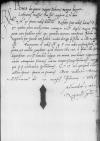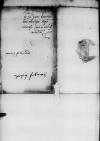List #1833
Bona Sforza do Ioannes DANTISCUSPiotrków, 1538-02-07
| odebrano [1538]-02-22 Rękopiśmienne podstawy źródłowe:
| ||||
Tekst + aparat krytyczny + komentarz Zwykły tekst Tekst + komentarz Tekst + aparat krytyczny
Reverendissimo paper damaged⌈[Reverendissimo]Reverendissimo paper damaged⌉ in Christo Patri, domino
Reverende in Christo Pater, sincere nobis dilecte.
Redditae sunt nobis cf.
Bene valeat.
Dat(ae) or Dat(um)⌈Dat(ae)Dat(ae) or Dat(um)⌉
Ad mandatum serenissimae maiestatis reginalis proprium


 BCz, 1601, p. 668
BCz, 1601, p. 668